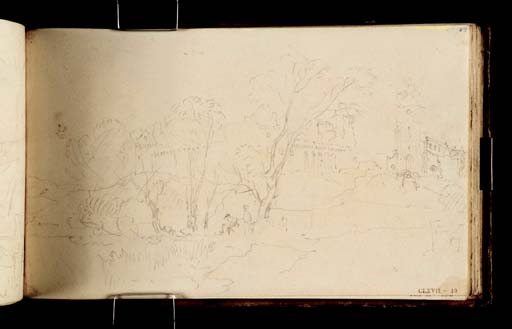Joseph Mallord William Turner Linlithgow 1818
Image 1 of 2
Joseph Mallord William Turner,
Linlithgow
1818
Joseph Mallord William Turner 1775–1851
Folio 51 Recto:
Linlithgow 1818
D13671
Turner Bequest CLXVII 49
Turner Bequest CLXVII 49
Pencil on white wove paper, 112 x 186 mm
Inscribed in blue ink ‘49’ top right
Stamped in black ‘CLXVII 49’ bottom right
Inscribed in blue ink ‘49’ top right
Stamped in black ‘CLXVII 49’ bottom right
Accepted by the nation as part of the Turner Bequest 1856
References
1909
A.J. Finberg, A Complete Inventory of the Drawings of the Turner Bequest, London 1909, vol.I, p.486, CLXVII 49, as ‘Linlithgow.’.
Linlithgow Palace and St Michael’s Church are here seen from a hundred metres or so to the south-west with Linlithgow Loch in the foreground at the left. Turner made three sketches of Linlithgow from the south-west (see folios 50 and 52; D13669, D13663; CLXVII 48 and 45b) and throughout many of his views of the subject in this sketchbook there is an interest in showing the three landmarks of Palace, Church and Loch and the elements, of architecture, trees and water.
Two figures, one standing and the leaning, are looking into the water and presumably fishing. The introduction of these figures – who may also appear on folio 50 (D13669; CLXVII 48) – represents a new stage in the development of Turner’s conception of the Linlithgow subject, and is a precursor to the man and dog that appear in the foreground of the 1821 watercolour, Linlithgow Palace (Manchester City galleries).1
Like other figures that appear in sketches of Linlithgow in this sketchbook (see for example folio 49; D13667; CLXVII 47), these two men stand around idly like tourists of the Picturesque, as Turner was himself. Others, such as those on 51 verso and 52 (D13672, D13663; CLXVII 49a, 45b) appear to belong more to the landscape, and it was such a figure – a tartan-clad cowherd – that Turner introduced into the Provincial Antiquities design, creating a pastoral scene where the palace and church appear to be natural elements of the landscape along with the trees, cows, hills and water. Cows appear in a sketch of Linlithgow on folio 51 verso. The sketch continues at the right onto the right of folio 52.
There is a yellow mark along the top edge of the page which has bled through from the painted page edges of the sketchbook.
Thomas Ardill
March 2008
How to cite
Thomas Ardill, ‘Linlithgow 1818 by Joseph Mallord William Turner’, catalogue entry, March 2008, in David Blayney Brown (ed.), J.M.W. Turner: Sketchbooks, Drawings and Watercolours, Tate Research Publication, December 2012, https://www


